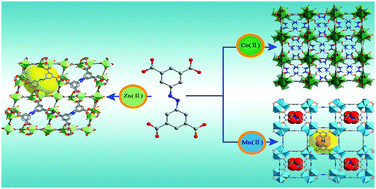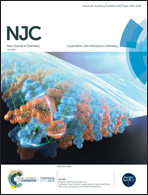Assembly of metal–organic frameworks based on 4-connected 3,3′,5,5′-azobenzenetetracarboxylic acid: structures, magnetic properties, and sensing of Fe3+ ions†
Abstract
Three metal–organic frameworks, {[Co2(ao0.34btc)(DMF)3]·3DMF}n (1), {(Me2NH2)2[Mn12(OH)4(abtc)6(DMA)6(H2O)6][Mn(H2O)4]·36H2O}n (2), and {[Zn3(abtc)1.5(H2O)2.5(DMA)0.5]·5DMA·2CH3OH}n (3), were successfully designed and synthesized by using H4abtc ligand under solvothermal conditions (H4abtc = 3,3′,5,5′-azobenzenetetracarboxylic acid, DMF = N,N-dimethyformamide, and DMA = N,N-dimethylacetamide). In complex 1, the ao0.34btc4− ligands connect [Co2(CO2)4] second building units (SBUs) to generate a three-dimensional (3D) crystal structure, showing the “PtS”-type topology. The [Mn3OH(CO2)6] SBUs connected by abtc4− produce the 3D “soc”-type cage in complex 2. Complex 3 consists of two categories of [Zn2(CO2)4] SBUs, resulting in the “NbO”-type cage with the assistance of the abtc4− ligands. Magnetic measurements reveal that antiferromagnetic exchange interactions exist in complexes 1 and 2. Besides, the luminescence investigations of complex 3 show its excellent sensing ability toward Fe3+ ions by fluorescence quenching.



 Please wait while we load your content...
Please wait while we load your content...